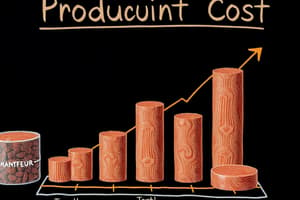Podcast
Questions and Answers
What happens to the marginal product of an input as more of that input is used?
What happens to the marginal product of an input as more of that input is used?
- It falls as more of the input is used. (correct)
- It initially increases and then decreases.
- It remains constant over time.
- It consistently increases.
Which equation represents the production function under the new technology at Burger Queen?
Which equation represents the production function under the new technology at Burger Queen?
- q = 20(KL) ½ (correct)
- q = 10(KL) ½
- q = 40(KL) ½
- q = 30(KL) ½
Which scenario would NOT likely increase production in a firm?
Which scenario would NOT likely increase production in a firm?
- Implementing new safety regulations. (correct)
- Utilizing more migrant workers.
- Increasing capital accumulation.
- Advancing technology.
What does a firm's technical efficiency indicate?
What does a firm's technical efficiency indicate?
How does technological progress affect production inputs?
How does technological progress affect production inputs?
What does the marginal product of labor represent when holding capital constant?
What does the marginal product of labor represent when holding capital constant?
At what point does total output maximize in relation to marginal product?
At what point does total output maximize in relation to marginal product?
How does the average product differ from the marginal product?
How does the average product differ from the marginal product?
What effect does increasing labor input typically have on total output?
What effect does increasing labor input typically have on total output?
Isoquants illustrate what concept in production?
Isoquants illustrate what concept in production?
Which statement best describes the relationship between marginal and average products as output increases?
Which statement best describes the relationship between marginal and average products as output increases?
What occurs to total production when the marginal product becomes negative?
What occurs to total production when the marginal product becomes negative?
What is the primary function of an isoquant in production theory?
What is the primary function of an isoquant in production theory?
How is the Marginal Rate of Technical Substitution (MRTS) mathematically defined?
How is the Marginal Rate of Technical Substitution (MRTS) mathematically defined?
Why does the slope of an isoquant represent a negative value?
Why does the slope of an isoquant represent a negative value?
What happens to MRTS as one moves down along an isoquant?
What happens to MRTS as one moves down along an isoquant?
Which of the following is NOT a property of isoquants?
Which of the following is NOT a property of isoquants?
What does a positive MRTS imply about the marginal products of labor (MPL) and capital (MPK)?
What does a positive MRTS imply about the marginal products of labor (MPL) and capital (MPK)?
Why are isoquants considered convex to the origin?
Why are isoquants considered convex to the origin?
What does it mean when MRTS is less than zero?
What does it mean when MRTS is less than zero?
What trade-off is represented by moving from one isoquant to another further from the origin?
What trade-off is represented by moving from one isoquant to another further from the origin?
What effect does technological progress have on a firm's production function?
What effect does technological progress have on a firm's production function?
Which of the following describes the scenario of input substitution?
Which of the following describes the scenario of input substitution?
What is the production function at Burger Queen when using 4 units of capital?
What is the production function at Burger Queen when using 4 units of capital?
What is indicated by the sum of the exponents α and β in the production function q = 10K^αL^β where α = ½ and β = ½?
What is indicated by the sum of the exponents α and β in the production function q = 10K^αL^β where α = ½ and β = ½?
How does average productivity change as more labor is employed at Burger Queen?
How does average productivity change as more labor is employed at Burger Queen?
What does the isoquant curve represent in a production function?
What does the isoquant curve represent in a production function?
If a firm maintains output while reducing labor, what is primarily being utilized?
If a firm maintains output while reducing labor, what is primarily being utilized?
What is the relationship between marginal product of labor (MPL) and output as more workers are utilized at Burger Queen?
What is the relationship between marginal product of labor (MPL) and output as more workers are utilized at Burger Queen?
What does the term 'returns to scale' refer to in the context of production functions?
What does the term 'returns to scale' refer to in the context of production functions?
Which statement is true regarding the isoquants compared to input substitution?
Which statement is true regarding the isoquants compared to input substitution?
What is the mathematical representation of the production of burgers at Burger Queen if the goal is to produce 40 burgers?
What is the mathematical representation of the production of burgers at Burger Queen if the goal is to produce 40 burgers?
Given the isoquant equation q = 40 = 10(KL)½, what does 'K' represent?
Given the isoquant equation q = 40 = 10(KL)½, what does 'K' represent?
What does MRTS stand for in the context of the burger production operation?
What does MRTS stand for in the context of the burger production operation?
If the MRTS between capital and labor is calculated as MRTS = - change in K / change in L, what is the result when considering the change of K from 5.3 to 4 and L from 3 to 4?
If the MRTS between capital and labor is calculated as MRTS = - change in K / change in L, what is the result when considering the change of K from 5.3 to 4 and L from 3 to 4?
As the number of workers increases in the production of burgers, what can be expected to happen to the MRTS?
As the number of workers increases in the production of burgers, what can be expected to happen to the MRTS?
What value does '16 = KL' derive from in the context of the isoquant map for Burger Queen?
What value does '16 = KL' derive from in the context of the isoquant map for Burger Queen?
In the context of burger production, what does a decreasing MRTS indicate about labor and capital substitution?
In the context of burger production, what does a decreasing MRTS indicate about labor and capital substitution?
Which of the following correctly defines the relationship expressed by 'MRTS = - change in K / change in L'?
Which of the following correctly defines the relationship expressed by 'MRTS = - change in K / change in L'?
If the MRTS between capital and labor when moving from 9 to 8 units of labor and 2 to 1.8 units of capital yields 0.2, which can be inferred about the production function?
If the MRTS between capital and labor when moving from 9 to 8 units of labor and 2 to 1.8 units of capital yields 0.2, which can be inferred about the production function?
What does the isoquant map illustrate in terms of production input combinations?
What does the isoquant map illustrate in terms of production input combinations?
Flashcards
Production function
Production function
A mathematical relationship showing how different combinations of inputs (like labor and capital) result in different levels of output.
Marginal product
Marginal product
The additional output produced by adding one more unit of a specific input (like labor) while keeping all other inputs constant. It's a measure of how much a unit of a specific input contributes to total output.
Average product
Average product
Total output divided by the number of workers. It shows the average productivity of all workers.
Isoquant
Isoquant
Signup and view all the flashcards
Returns to scale
Returns to scale
Signup and view all the flashcards
Input substitution
Input substitution
Signup and view all the flashcards
Technological change
Technological change
Signup and view all the flashcards
What is an isoquant?
What is an isoquant?
Signup and view all the flashcards
What is marginal product?
What is marginal product?
Signup and view all the flashcards
What are returns to scale?
What are returns to scale?
Signup and view all the flashcards
What is input substitution?
What is input substitution?
Signup and view all the flashcards
What is a production function?
What is a production function?
Signup and view all the flashcards
What is the Marginal Rate of Technical Substitution (MRTS)?
What is the Marginal Rate of Technical Substitution (MRTS)?
Signup and view all the flashcards
What is average product?
What is average product?
Signup and view all the flashcards
What is technological change?
What is technological change?
Signup and view all the flashcards
Technological Progress
Technological Progress
Signup and view all the flashcards
Constant Returns to Scale
Constant Returns to Scale
Signup and view all the flashcards
Decreasing Returns to Scale
Decreasing Returns to Scale
Signup and view all the flashcards
Increasing Returns to Scale
Increasing Returns to Scale
Signup and view all the flashcards
Average Productivity
Average Productivity
Signup and view all the flashcards
Diminishing Marginal Product
Diminishing Marginal Product
Signup and view all the flashcards
Total Output
Total Output
Signup and view all the flashcards
What is MRTS?
What is MRTS?
Signup and view all the flashcards
How do you calculate MRTS?
How do you calculate MRTS?
Signup and view all the flashcards
Why does the slope of an isoquant flatten out?
Why does the slope of an isoquant flatten out?
Signup and view all the flashcards
Why must the MRTS be always positive?
Why must the MRTS be always positive?
Signup and view all the flashcards
How do isoquants represent different levels of output?
How do isoquants represent different levels of output?
Signup and view all the flashcards
Why don't isoquants cross each other?
Why don't isoquants cross each other?
Signup and view all the flashcards
Why are isoquants downward sloping?
Why are isoquants downward sloping?
Signup and view all the flashcards
Why are isoquants convex?
Why are isoquants convex?
Signup and view all the flashcards
Marginal Rate of Technical Substitution (MRTS)
Marginal Rate of Technical Substitution (MRTS)
Signup and view all the flashcards
Study Notes
Production Overview
- Production is the process of turning inputs into outputs.
- A firm's production function mathematically describes the relationship between inputs and outputs.
- The production function is often represented as q = f(K, L), where q represents output, K represents capital, and L represents labor.
Chapter Preview
- The study of production examines how output changes as a firm increases the number of inputs.
- It explores the degree to which inputs can be substituted for one another.
- The impact of technological change on production is also a key area of investigation.
Overview of Production Concepts
- Total Output, Marginal, and Average Product: These concepts examine the relationship between input quantities and output levels, specifically how adding more of a single input (like labor) affects overall output while holding other inputs constant.
- Isoquants: These curves illustrate different input combinations that produce the same level of output. They are useful for analyzing input substitution.
- Returns to Scale: This analyzes how output changes when all inputs are increased proportionally. Returns to scale can be constant, increasing, or decreasing.
- Input Substitution: The ability and motivations for firms to substitute one input for another (e.g., labor for capital).
- Technological Change: Technological progress leads to a shift in the production function, allowing the same output to be produced with fewer inputs.
Production Functions
- A production function describes the relationship between inputs and outputs.
- The function visually represents how a firm converts inputs to output.
Marginal Product
- Marginal Product (MP) measures the change in output resulting from a one-unit increase in a single input, while holding other inputs constant.
- MPL (Marginal Product of Labor) measures how output changes with labor input
- MPK (Marginal Product of Capital) measures how output changes with capital input
Total Output and Marginal Product
- Total output typically increases as more of an input (like labor) is added, but at a diminishing rate (diminishing returns).
- Marginal product (MP) initially rises, then falls as more of an input is used.
Average Product
- Average Product (AP) is calculated by dividing total output by the number of units of the input.
- AP is a measure of the productivity of all inputs.
Average and Marginal Products
- The relationship between the average product and marginal product of an input shows a key pattern:
- Average Product (AP) increases when marginal product (MP) per unit is greater than the average product (AP).
- Average product (AP) decreases when marginal product (MP) per unit is less than the average product (AP).
- Marginal product (MP) equals average product (AP) at the maximum of the average product (AP).
Total Output, Average and Marginal Products
- Total Product (TP) is maximized where the Marginal Product (MP) of the variable input is zero.
- Total product falls when the marginal product (MP) is negative.
- Total product rises when the marginal product (MP) is positive.
Isoquants
- Isoquants demonstrate various input combinations that produce the same level of output.
- Isoquants are downward sloping and convex, reflecting diminishing marginal rate of technical substitution.
Marginal Rate of Technical Substitution (MRTS)
- MRTS measures the rate at which one input can be substituted for another while keeping output constant.
- MRTS is equal to the negative of the slope of the isoquant curve.
- MRTS is inversely proportional to the marginal productivity of inputs: MRTSLK = MPL / MPK.
MRTS and Marginal Product
- The relationship between MRTS and marginal products helps explain why isoquants are downward-sloping and convex.
Isoquants continued
- As more of one input is used, the rate at which the other input can be reduced to maintain the same output level (MRTS) diminishes.
Returns to Scale
- Returns to scale describe how output changes when all inputs are increased proportionally.
- This can be constant, increasing or decreasing returns.
Returns to Scale and Cobb-Douglas Functions
- The sum of exponents in a Cobb-Douglas production function indicates the returns to scale.
- CRS (Constant Returns to Scale) = α + β = 1.
- IRS (Increasing Returns to Scale) = α + β > 1.
- DRS (Decreasing Returns to Scale) = α + β < 1.
Isoquants and Returns to Scale
- Returns to scale are illustrated in isoquant maps, which show how the isoquant curves change based on the return to scales.
Returns to Scale vs. Marginal Returns
- Returns to scale consider changes in all inputs
- Marginal Returns involve changes to a single input while holding others constant
Input Substitution
- Firms substitute inputs in response to price changes to minimize costs.
- A Fixed proportions production function means inputs are used in fixed ratios.
Fixed Proportions Production
- In a fixed proportions production function, inputs must be used in fixed ratios.
- Isoquants are perfectly straight lines in fixed proportions. This signifies no substitution between inputs to maintain a particular output level
Changes in Technology
- Technological progress leads to a shift in the production function.
- This shift allows the same output levels to be produced with fewer inputs or potentially greater output with existing inputs.
Changes in Technology vs. Input Substitution
- Technological changes result in new and distinct production functions.
- Input substitution occurs in response to price fluctuations to lower production costs.
Numerical Production Example
- Example calculation of production for a burger restaurant (Burger Queen), illustrating constant returns to scale in a Cobb-Douglas Function.
Constant Returns to Scale at Burger Queen
- Numerical example demonstrating constant returns to scale for a burger restaurant.
Average and Marginal Product at Burger Queen
- Example calculation of average and marginal products for labor at Burger Queen (with different capital levels).
Isoquant Map for Burger Queen
- Calculating the combination of capital and labor to produce a specific level of output.
MRTS at Burger Queen
- Example calculation of MRTS for different combinations of inputs to maintain a constant output level.
MRTS at Burger Queen
- The MRTS falls as more labor is employed: for additional outputs, the firm will need a declining amount of substitution for capital
Technological Progress at Burger Queen
- Example showing how technological improvements in an industrial process (such as hamburgers flipping themselves) can change a firm's production function and thereby achieve output goals with less input
Technological Progress at Burger Queen Continued
- Illustrative example using numerical and graphical representations to compare production functions before and after a technological advancement.
Recap
- Summarization of key production concepts (marginal product, isoquants, MRTS, returns to scale).
- Explanation of conditions where production methods can and cannot be substituted to achieve a specific output.
Practice Quiz Questions
- Multiple choice questions to test understanding of production concepts, focusing on identifying factors increasing production and defining key terms.
- Questions relate to production and efficiency criteria
Problem 1
- Case study involving a flower producing company (Jasmin) illustrating various aspects of production concepts: average and marginal products of fertilizers, diminishing marginal returns, and total returns.
Studying That Suits You
Use AI to generate personalized quizzes and flashcards to suit your learning preferences.
Related Documents
Description
This quiz covers fundamental concepts in production theory, focusing on marginal product, technological progress, and efficiency. Test your understanding of how inputs affect output and the relationships between average and marginal products in various scenarios.



